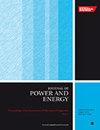Secondary air induced flow structures and their interplay with the temperature field in fixed bed combustors
IF 1.1
4区 工程技术
Q3 ENGINEERING, MECHANICAL
Proceedings of the Institution of Mechanical Engineers, Part A: Journal of Power and Energy
Pub Date : 2024-08-26
DOI:10.1177/09576509241275778
引用次数: 0
Abstract
Air staging in solid fuel combustion features widely in small scale domestic boilers to large scale moving grate combustors. Whilst the effects of air staging on the combustion characteristics of these systems are generally known, there is very little insight available into the role of secondary air on the flow and temperature field in the freeboard of batch-type fixed bed biomass combustors. Three-dimensional gas phase simulations using the Transition 𝑘kl-𝜔 and Finite Rate/Eddy Dissipation models were validated against freeboard temperatures and emissions (CO固定床燃烧器中的二次气流诱导结构及其与温度场的相互作用
从小型家用锅炉到大型移动炉排燃烧器,固体燃料燃烧过程中的空气分级都非常普遍。虽然空气分级对这些系统的燃烧特性的影响已广为人知,但对于二次空气对间歇式固定床生物质燃烧器自由板中的流动和温度场的作用却知之甚少。使用过渡𝑘kl-脯和有限速率/埃迪耗散模型进行的三维气相模拟与在同一装置上测量的自由板温度和排放物(CO2 和 O2)进行了验证。结果表明,Qs/Qt ≥ 0.25 时,二次空气会在其注入点的上游和下游形成两个再循环区,在这些再循环区周围通常会观察到最高的自由板温度;如果 Qs/Qt 降至 0.12-0.18,则只会观察到上游再循环区,直到 Qs/Qt = 0.06 时才会减弱。但是,如果 Qs/Qt 增加到 0.25 至 0.71 之间,似乎会产生冷却效应,这就需要权衡利弊。建模结果表明,在反应情况下,与相同几何形状的非反应建模不同,二次空气诱导的上游再循环区的强度明显更强。
本文章由计算机程序翻译,如有差异,请以英文原文为准。
求助全文
约1分钟内获得全文
求助全文
来源期刊

CiteScore
3.30
自引率
5.90%
发文量
114
审稿时长
5.4 months
期刊介绍:
The Journal of Power and Energy, Part A of the Proceedings of the Institution of Mechanical Engineers, is dedicated to publishing peer-reviewed papers of high scientific quality on all aspects of the technology of energy conversion systems.
 求助内容:
求助内容: 应助结果提醒方式:
应助结果提醒方式:


